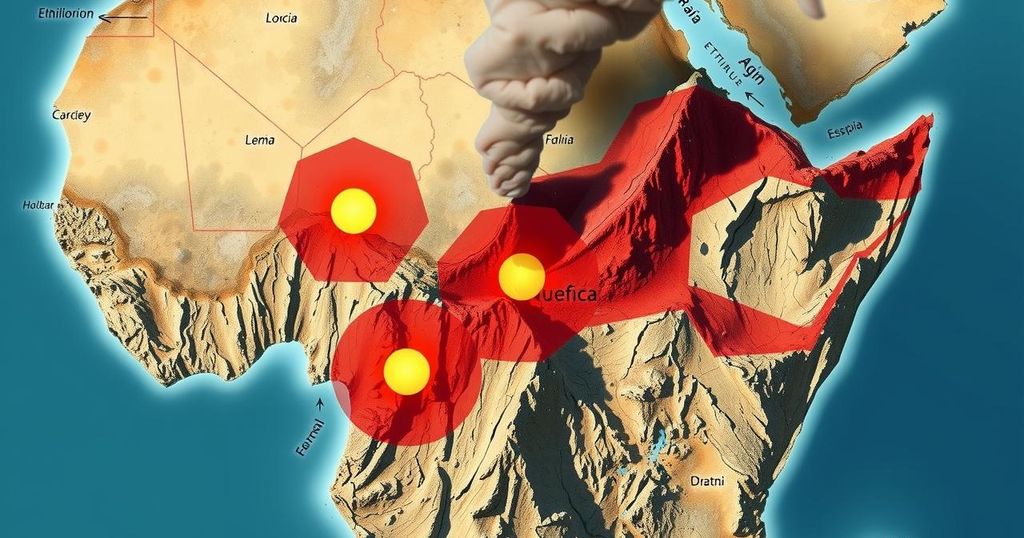Ethiopia Earthquakes Raise Alarms, But GERD Remains Secure According to Experts

Ethiopia’s recent earthquakes have led to concerns about their impact on the Grand Ethiopian Renaissance Dam (GERD). Sudanese experts have assured that the quakes are too distant to threaten the dam’s integrity. Although hypothetical scenarios of dam failure would have dire consequences for Sudan, assessments indicate a low risk. Calls for scientific collaboration on water resource management highlight ongoing concerns in the Nile Basin region.
Recent seismic activity in the Afar region of northwestern Ethiopia has raised concerns regarding its potential impact on the Grand Ethiopian Renaissance Dam (GERD) and its implications for Sudan and Egypt. Despite these tremors prompting over 80,000 evacuations, Sudanese geoscientists assure that the quakes pose no immediate risk to the dam. The quakes, with the latest measured at 8.1 magnitude, have originated over 100 kilometers from the GERD, which was intentionally designed to be resilient to seismic activity. Sudanese surveying and earth sciences expert Abdelkarim El Amin affirmed that even hypothetical scenarios of dam failure would lead to severe consequences in Sudan, necessitating immediate scientific investigation into dam safety and environmental impacts.
Geoscientific assessments suggest that the GERD can withstand seismic disturbances, and its location remains safely distanced from the current quakes. This reassures that Ethiopia’s extensive studies on the site’s geological conditions during construction have prioritized safety. Moreover, despite assertions about potential leaks affecting the dam, experts believe that these issues are unlikely given the current seismic profile. Consequently, an investigation into the dam’s environmental effects in the Nile Basin is encouraged, emphasizing the necessity for a scientific approach in understanding regional water resource issues.
While an unlikely total collapse of the GERD due to seismic activity is posited, El Amin highlighted that any failure, partial or complete, could significantly inundate the surrounding areas of Sudan, affecting existing dams and infrastructure along the Nile. Furthermore, he noted that flooding could extend from Khartoum into upper regions and affect vital agricultural zones. Given these potential risks, enhanced collaboration between Sudan’s water resource authorities and scientific bodies is critical to addressing any underlying concerns impacting both the GERD and regional water security.
The Grand Ethiopian Renaissance Dam (GERD) is a major infrastructure project aimed at addressing Ethiopia’s energy needs and facilitating regional development. Located near the eastern Ethiopian border, the dam has been a point of contention among Ethiopia, Sudan, and Egypt due to its strategic importance to water resources in the Nile Basin. Recent earthquakes in the Afar region have raised alarm concerning the dam’s structural integrity and the potential for downstream flooding, reinforcing the necessity of assessing geological risk factors and water management policies among the three nations. Sudanese geoscientists play a key role in monitoring and evaluating these risks, owing to their geographical proximity and reliance on the Nile for agricultural and domestic needs.
In summary, while the recent earthquakes in Ethiopia have raised concerns regarding their impact on the Grand Ethiopian Renaissance Dam, experts maintain that the dam is positioned far from the seismic activity. The integrity of the GERD remains a focal point for both Sudan and Egypt; however, potential flooding scenarios following any dam failure would necessitate comprehensive regional studies and collaboration. Adequate scientific investigations into the dam’s effects on the environment and surrounding communities are paramount. The call to engage experts in a non-political context underscores the importance of addressing regional water resource management thoughtfully and systematically.
Original Source: www.dabangasudan.org






